Abstract
Environment and climate change have caused a rise in a wide range of diseases and infections. In countries where overpopulation is a problem, many infections spread severely. The main focus of this paper is the detection and identification of blood diseases. An automated system that examines all potential diseases using patient information and data is needed to deal with unpredictable circumstances. Having an automated and intelligent system that evaluates the reports and counsels doctors in any other area or nation is a demand of the time. The same solutions can be identified by the proposed system. To apply the adaptive neuro-fuzzy inference system (ANFIS) and related techniques to predict chronic diseases early, the authors have gone through various existing models and case studies on diabetics and other patients. The proposed approach, called S-ANFIS which is using the hybrid approach, is based on ANFIS and includes content curation and intelligence analysis in addition to comparison with current models. As a result, the suggested model outperforms other approaches in terms of disease prediction accuracy, with a score of 88.6%.
1. Introduction
In developing countries such as India, the health sector is not as developed and advanced in comparison to developed countries. With the increase in population and changes in the environment, a wide variety of diseases, sicknesses, and infections are growing. To deal with uncertain circumstances, an automatic system is required which takes the details of the patient and the statistics and understands all the possible sicknesses. Every minute, information about patients gets retrieved. For instance, there is some hassle in Brazil and an identical situation is occurring in India, so the health practitioner in India would come to recognize approximately it. Eventually, the doctor in India can consent to the physician abroad and then be able to check the contamination history and the treatment. The proposed solution assists doctors to get accurate detection of newly introduced viruses and infections. The model is based on the adaptive neuro-fuzzy inference system with content curation and an intelligent analyzer; here, the proposed system has been given the name S-ANFIS. Before moving to the proposed system, the article discusses the basics of artificial intelligence and neural network for new researchers.
Nowadays, in the medicinal field, the classification and segmentation part becomes easy using machine learning methodologies. Ferraz, A. et al. highlighted in their research computer vision and machine learning methods for the classification of blood types [1]. Similar to the work in the mentioned article, the authors are using machine learning and a smart hybrid approach to work on blood infections. Vellido [2] discussed the importance of machine learning approaches in the health and medicine sector. In the paper, Vellido listed various methods and techniques for interpretability and the visualization of the various factors in medicine and the health sector. Current research has focused heavily on the use of cloud computing and image recognition technology to aid in medical diagnosis, which has enormous potential to further improve real-time detection and advance medical diagnosis [3]. This is the main reason, in this paper, the machine learning techniques and the smart ANFIS algorithm are applied to improve the efficiency of the system in the detection of blood infections.
Various papers used simple approaches such as fuzzy rules and simple methods which take the user parameters. Based on the range, the outcome is defined. Emmanuel et al. [4] discussed a similar approach in their paper; the authors focused on the data collected at the Tafo hospital in Ghana. The dataset is of pregnant women and blood protozoan infections. Similarly, Keisuke Okaba et al. [5] discussed the study of blood-borne infections in the special cases of Chiba, Japan. In another paper, Mesut et al. discussed the classification of white blood cells and how the change has occurred in the formation of white blood cells. The authors had done the task using the convolution neural network and machine learning algorithms [6]. In addition to the above scenario, Yan Lu et al. [7] also used the algorithm based on UNet++ and ResNet, where the white blood cells are identified and segmented. These are not the only articles to work with machine learning; there are thousands of articles available where machine learning and artificial intelligence are applied to the system to make it efficient and accurate.
Outcome
The main problems in the current scenario of medical science are the increase in population and changes in the environment, a wide variety of diseases, sicknesses, and infections are growing. To deal with uncertain circumstances, an automatic system is required which takes the details of the patient and the statistics and understands all the possible sicknesses. From the information of patients, information gets retrieved every minute. There are various countries where many diseases are un-curable, and doctors are unable to deal with the diseases. The proposed system will help in such scenarios.
In the article, a novel hybrid approach is used to find out the blood infections based on the blood samples. Currently, reports have been generated that highlight the normal range of parameters considered; however, the proposed system will also give the name of the infection if it exists in the person’s report and the most suitable treatment based on the experts’ advice. In the system, the Smart adaptive neuro-fuzzy inference system (S-ANFIS) is used and demonstrated on 1000 blood samples.
2. Literature Survey
Various works have been done in the field of infection detection and prediction. Some of the major contributions are highlighted in this section in Table 1.

Table 1.
Comparison Table.
Edward et al. (1970) [8] discussed the approach of MYCIN, which is a well-known expert system. The authors discussed the rule-based system, which takes the input and matches the data within the dataset of existing rules. Now the system is changed. The need is to add new rules with the existing ones so that the data fetched by the end users are more accurate and the efficiency of the system will increase. Ayangbekun et al. [20] also discussed the same concept and added updates to the dataset. In their paper, specific diseases are targeted and identified to work on. Various countries have many diseases that are un-curable and doctors are unable to deal with the diseases. The proposed system will help in such scenarios [21,22,23].
Alexander Hawley, “Fuzzy Nets: Fuzzy Logic and Neural”, and how neural networks and fuzzy logic work with one another [24]. There is a system derived for medical purposes where high computing services can be availed. The computing systems can have the power of CPU and GPU. The blood reports can also be used as scanned documents and the GPU fetches the details of the blood parameters. Likewise, the parameters are curated and analysed to give the proposed model the outcome after mining the results from the database [25,26].
There are two technologies, i.e.,
- Fuzzy logic
- Neural Network
These two different technologies can be combined to complete things with great quickness. The easiest way to connect both fuzzy logic and neural network technologies is to make a Fuzzifier as shown in Figure 1.
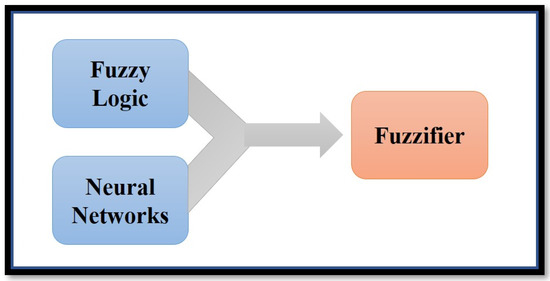
Figure 1.
Combination of two technologies, i.e., Fuzzy and Neural.
Shikha Aggarwal et al. discussed their work in their study where cancer is diagnosed using a neural network. Cancer is a dreadful disease, and every year many people died from the disease, in their survey of various neural network techniques for the classification of cancer [27]. Jangra et a. 2020 [28] elaborates on the study done on mice. Their paper showed substantial evidence which identified various diseases. In their paper, the authors also indicated the reasons for psychological and physiological anomalies. Gupta and Patil 2020 [29], have suggested remedial actions for Alzheimer’s disease.
The second part of the survey discussed the approaches related to the adaptive fuzzy system. Like in Figure 2, ANFIS-Net for automatic detection of COVID-19 is shown [30]. The parameters taken are well discussed and computed the outcome in the form of the COVID-19 positive or not.
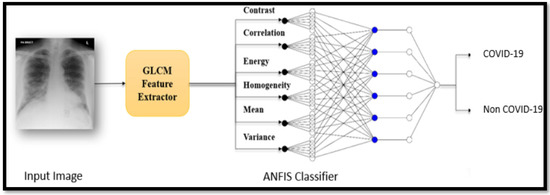
Figure 2.
Combination of two technologies, i.e., Fuzzy and Neural.
Similarly, to process the data fetching and processing contain multiple steps. In the model discussed in the paper by M. M. Islam et al. [31], the data pre-processing is shown in Figure 3.
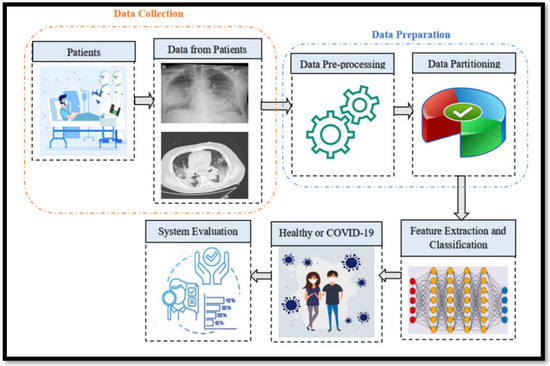
Figure 3.
Data pre-processing of the evaluation of the result.
As discussed above, many applications in the medical field are based on neural networks and fuzzy logic. Wherein ANFIS is an adaptive method that incorporates both solved and various issues. However, the neural network is not suitable for modelling when the information is incomplete or imprecise. M. Nilashi et al. [32] discussed a method shown in Figure 4 which uses the ANFIS model for hepatitis diagnosis.
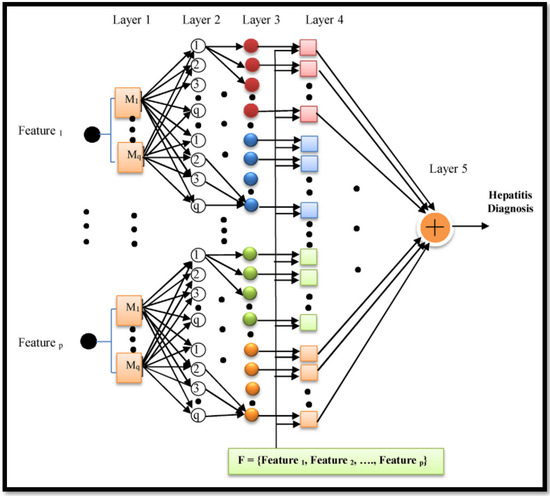
Figure 4.
ANFIS model for hepatitis diagnosis.
In the same manner, the authors in [33] elaborated on the approach for diabetes control using a decision-making system based on multiple criteria; another work is to find chronic disease prediction using machine learning [34]. The scope in the medical field is much more than the expectation. Padmavathy et al. insight into the method and system for breast cancer detection using adapting clustering [35]. Various other approaches are also discussed in the paper, and the proposed work is inspired by the above-cited contributions.
In this paper, the focus of the authors is on the hybrid approach of ANFIS and other factors which gives better results. Though, many versions of ANFIS are used on various applications and domains; on the same road, authors tried to explore the major versions of the ANFIS algorithm on multiple applications. Jagan M. R. T. et al. [36] used the adaptive fuzzy algorithm for the transmission line controllers, where the authors implemented the results on a MATLAB simulator. Zhan Zhang et al. [37] explained the system based on the ANFIS model which takes the 3D pulse image of Chinese medicine. The authors of the paper discussed the analysis of the image and the contour of the medicinal images. In the paper, with ANFIS, a genetic algorithm is also used to make the hybrid model for implementation and got better results. In another paper, Ali Behnood et al. [38] expressed their views on the COVID-19 virus infections in the US and how the virus optimization algorithm is determined. The paper elaborated on the combination of ANFIS and virus optimization algorithm (VOA), and the infection rate of COVID-19 is investigated.
The papers discussed in the above paragraph were related to the ANFIS and its versions. Similarly, other papers are also available which ensure better results in the hybrid or curated model of ANFIS. In a paper titled “Long-term prediction of blood pressure time series using ANFIS system based on DKFCM clustering”, the same sort of hybrid ANFIS was applied which outperformed FCM, KFCM, and other clustering methods [39]. In another paper [40], authors used the ANFIS classifier for probable Alzheimer’s disease and early detection of mild cognitive impairment (MCI) [40].
3. Proposed Work
The proposed model is an Intelligent Automated System that takes a patient’s blood report from a diagnostic centre and applies fuzzy rules, a database, and a neural network to it. Fuzzy rules imply that the inference engine retrieves the blood report parameters and recognizes new infections, and how neural networks operate is when a new case is received, the neural network learns the new rules and cases.
Fuzzy Logic Algorithm
The algorithm used in the proposed model is based on the Adaptive neuro-fuzzy inference system (ANFIS). The smarter and automated rules are implemented in the proposed system to give accurate and better results. The pseudo-code of the algorithm is shown below as Algorithm 1. and the proposed model are shown below:
| Algorithm 1. Pseudocode. |
| Input: Blood Report |
| Output: Abstracted summary with infection and treatment |
| Steps to perform: |
| 1. Perform pre-processing to convert input values into readable values and reduce the dimensionality. |
| 2. Extract the major features from the input values and match the input value with respect to the ideal parameter range, and treat this as an outcome (1). |
| 3. Use the fuzzy inference system rules on the outcome values (1). |
| 4. Based on the scores and the ANFIS model, the prediction of blood infection is considered as the outcome (2). |
| 5. Check the outcome (2) and apply the Neuro-fuzzy system to get the appropriate treatment from experts’ databases; this treatment string is considered as the outcome (3). |
| 6. The obtained values (2) and (3) are shown to the users on the interface as the final output. |
The above code expressed the way how the proposed system will work and extract the major features using PCA. Following the application of criteria, our system generates statistical results, such as the detection of infection and subsequent treatment with a doctor or expert consultant. Figure 5 illustrates the details [41,42].

Figure 5.
Proposed system model and flow process [41,42].
The nine input parameters were considered from the patient’s blood report, which was taken by a professional blood sample collection centre or given by the authorized blood testing centre. Based on the values of nine blood report parameters, the values are examined. The role of the proposed system starts from this step. The inference rules are applied to the values of the parameters and the multiple cross-validating factors to identify the infection in the patient’s body. The novel approach to the model is to suggest the disease and its remedial plan with treatment and deficiency. All such outcomes are derived from the blood report.
Based on the above pseudo-code, the Algorithm 2 to work is as follows:
| Algorithm 2. Blood Infection Algorithm. |
|
The above algorithm is demonstrated and implemented with the sigmoidal membership function. The implementation is discussed in Section 4.
4. Implementation
The simulation of the proposed model and the algorithm is done on the Param-Shavak system. For high-performance computation, the Param-Shavak desktop supercomputer by CDAC India is used. The Param Shavak has dual intel Xenon Gold 6132, 14 cores server-grade processors with each core having a minimum 2.6 GHz clock speed, 96 GB (expandable) DDR4 2666 MHz RAM in a balanced configuration, two 1 GbE networks ports, 2 × 16 PCI-E Gen3 slots for GPU/Co-processors with NVIDIA P5000 GPUs. The detailed code is available at https://github.com/harshkhatter/blood_infection_code/tree/main (accessed on 4 October 2022). In this application, various packages are used which are listed below:
- MainActivity.java
- ○
- MainActivity
- ○
- Fuzzylogic()
- MedihelpDatabase.java
- AndroidMenifest.xml
- ○
- Manifest
- ○
- Application
- ○
- Activity_main.xml
- ○
- Linearlayout
- ○
- Scrollview
- utility.java
- ○
- Utility (parameters/range)
- colours.xml
- ○
- Resources
- ○
- colors
- main_menu.xml
- Translation editor
- Bloodsample.java
- ○
- BloodSample
4.1. Components of Complete Blood Count
In the blood sample, the list and the abbreviation of the parameters are mentioned below. These parameters are taken to analyze and conclude the outcome of the proposed model.
4.1.1. Haemoglobin (HB)
Haemoglobin (Hb) is the protein contained in red blood cells that is responsible for the delivery of oxygen to the tissues. To ensure adequate tissue oxygenation, a sufficient haemoglobin level must be maintained.
4.1.2. Red Blood Cells (RBC)
The red blood cell (RBC) count is a test used to measure the number of oxygen-carrying blood cells in a volume of blood. It is one of the main tests doctors use to determine how much oxygen is being transported to cells of the body.
4.1.3. Platelet Count (PC)
Platelets are tiny cells made in the bone marrow. Platelets are very important, as they prevent bleeding by forming clots and sealing blood vessels if they become damaged. A normal platelet count ranges from 150,000 to 450,000 per microliter (mcL) of blood.
4.1.4. Hematocrit Value (HCT)
Hematocrit (HCT) is the proportion, by volume (expressed in percentage) of the blood that consists of red blood cells. For example, a hematocrit of 35% means that there are 35 mL of red blood cells in 100 mL of blood.
4.1.5. Mean Corpuscular Vol. Mass (MCV)
The mean corpuscular volume (MCV) is the average size of your red blood cells. If the value is bigger than normal, the MCV score goes up. That could indicate low vitamin B12 or folate levels. If the red blood cells are smaller, they could have a type of anaemia. A normal MCV score is between 76 and 96.
4.1.6. Mean Corpuscular Haemoglobin (MCH)
Mean corpuscular (or cell) haemoglobin is an estimate of the amount of Haemoglobin in an average red blood cell. Haemoglobin is a substance in the blood that carries oxygen to the cells in the body from the lungs.
4.1.7. Mean Corpuscular Haemoglobin Concentration (MCHC)
MCHC checks the average amount of Haemoglobin in a group of red blood cells.
4.1.8. Red Blood Cell Distribution width (RDW-CV)
It is a measure of the range of variation of red blood cell (RBC) volume that is reported as part of a standard complete blood count
4.1.9. Blood Sugar (BS)
Glycaemia, also known as blood sugar level, blood sugar concentration, or blood glucose level is the measure of glucose concentration in the blood.
The total taken blood components are mentioned in Table 2, for each component of blood, the specified range of the parameter is also shown in the table.

Table 2.
Blood Report Parameters and their ideal range with measuring units.
Table 3, Table 4, Table 5 and Table 6 shows the four samples and the ranges of the taken parameters and the ideal ranges are also shown. The ideal range with the dataset created and the rules used are considered. Similarly, the rules are applied to all taken inputs and the processed outcome is the Disease, Treatment predicted by the system in the expert’s observation.
In Table 3, patient 1 details were taken. Based on the nine defined parameters, the ideal range is mapped and analyzed. This analysis results in the output of the system which highlighted the possible disease of patient 1 and the most preferred treatment based on the expert’s validation. In the case of patient 1, Vitamin (B12) deficiency is found; the suggested treatment is the injections of B12 which is based on the values fetched by the proposed system.

Table 3.
Sample 1 and its outcome.
Table 3.
Sample 1 and its outcome.
| Parameters | Input Values of Sample 1 | Ideal Range | Disease | Treatment | Expert |
|---|---|---|---|---|---|
| HB | 6.5 (L) | 13.5 to 17.5 | Vitamin (B12) | Injection (B12) | (V) |
| RBC | 1.8 (L) | 3.5 to 6.5 | |||
| PC | 180 (N) | 150 to 450 | |||
| HCT | 19.5 (V.L.) | 35 to 54 | |||
| MCV | 109.6 (H) | 76 to 96 | |||
| MCH | 36.5 (H) | 27 to 32 | |||
| MCMC | 33.3 (N) | 30.5 to 34.5 | |||
| RDW-CV | 17.0 (H) | 11 to 16 | |||
| BS | 101.4 (N) | 70 to 150 |
In Table 4, patient 2’s details were taken. Based on the nine defined parameters, the analysis is done which highlighted the possible disease of patient 2 and the preferred treatment based on the expert’s validation. Like in the case of patient 2, no disease is suggested by the system and the outcome is Healthy. No deficiency is found, and No suggested treatment is given by the proposed system.

Table 4.
Sample 2 and its outcome.
Table 4.
Sample 2 and its outcome.
| Parameters | Input Values of Sample 1 | Ideal Range | Disease | Treatment | Expert |
|---|---|---|---|---|---|
| HB | 14.9 (N) | 13.5 to 17.5 | Healthy | (V) | |
| RBC | 4.25 (N) | 3.5 to 6.5 | |||
| PC | 305 (N) | 150 to 450 | |||
| HCT | 33.6 (L) | 35 to 54 | |||
| MCV | 95.5 (N) | 76 to 96 | |||
| MCH | 31.0 (N) | 27 to 32 | |||
| MCMC | 31.50 (N) | 30.5 to 34.5 | |||
| RDW-CV | 16.5 (H) | 11 to 16 | |||
| BS | 121 (N) | 70 to 150 |
In Table 5, patient 3’s details were taken. In the case of patient 3, a deficiency of iron is detected by the proposed system. As the deficiency can be overcome by the supplements, then the system suggested the intake of the “Iron supplement”.

Table 5.
Sample 3 and its outcome.
Table 5.
Sample 3 and its outcome.
| Parameters | Input Values of Sample 1 | Ideal Range | Disease | Treatment | Expert |
|---|---|---|---|---|---|
| HB | 10.1 (L) | 13.5 to 17.5 | Iron Deficiency | Iron Supplement | (V) |
| RBC | 2.8 (L) | 3.5 to 6.5 | |||
| PC | 232 (N) | 150 to 450 | |||
| HCT | 31 (L) | 35 to 54 | |||
| MCV | 55 (V.L.) | 76 to 96 | |||
| MCH | 31.9 (N) | 27 to 32 | |||
| MCMC | 31.8 (N) | 30.5 to 34.5 | |||
| RDW-CV | 11.0 (N) | 11 to 16 | |||
| BS | 91 (N) | 70 to 150 |
In Table 6, the critical patient details were taken. In the analysis, it was found that the values of the nine parameters are deriving a severe impact on the patient’s health and concluded that blood cancer. This is the outcome of the parameter values and the training and testing of the proposed model on specific conditions and implementation details. The treatment for such cases is chemotherapy.

Table 6.
Sample 4 and its outcome.
Table 6.
Sample 4 and its outcome.
| Parameters | Input Values of Sample 1 | Ideal Range | Disease | Treatment | Expert |
|---|---|---|---|---|---|
| HB | 11.2 (L) | 13.5 to 17.5 | Blood Cancer | Chemo-Therapy | (V) |
| RBC | 4.92 (N) | 3.5 to 6.5 | |||
| PC | 365 (N) | 150 to 450 | |||
| HCT | 36.8 (N) | 35 to 54 | |||
| MCV | 74.8 (L)) | 76 to 96 | |||
| MCH | 22.8 (L) | 27 to 32 | |||
| MCMC | 30.60 (N) | 30.5 to 34.5 | |||
| RDW-CV | 14.7 (N) | 11 to 16 | |||
| BS | 128.4 (N) | 70 to 150 |
4.2. Fuzzy Inference System
In the proposed model, the rules are applied to the blood report parameters and the ranges of the parameters are defined. Based on the rules, the database of rules is created. Whenever a new query is asked, the query goes via the fuzzy inference system and the dataset starts searching. When the query is mined and results are curated, the respective details are shown to the end user, i.e., doctor or patient.
The dataset of reports of previous patients gets stored and compiled at regular intervals. Here, the adaptive machine learning algorithm is applicable and clubbed with the RNN model; the outcome is discussed in Section 5, i.e., results and discussions.
5. Results and Discussion
The outcome of the proposed model and the suggested algorithm is to help the end users. The results are highly convincing. The diagnosis of blood diseases will be easier to recognize with the proposed model and approach used. Fuzzy Inference System with the help of S-ANFIS which interacts with users via a user interface.
Creating a database for Patient Blood Sample Parameters and the ranges as:
- If the input value is greater than the range
- If the input value is lesser than the range
- If the input value is in between the range
Range Limit of Linguistic Variables and the Corresponding of Input Data
The Range limit of linguistic Variables (LOW, VERY_LOW, NORMAL, HIGH, VERY_HIGH) and the corresponding input data (HB, RBC, PC, HCT, MCV, MCH, MCHC, RDW_CV, BS) as shown in Table 7.

Table 7.
Range Limit of Linguistic Variables and the Corresponding of Input data.
To test the proposed system and its functionality, the sample blood reports and the fetched parameters are taken. The blood parameters have some values to check on the simulator and the outcomes are shown in the figure. Table 8, Table 9 and Table 10 show the parameters and the values of a person after the blood test. The results fetched from our proposed system are very much accurate.

Table 8.
Patient Blood Report 1.

Table 9.
Patient Blood Report 2.

Table 10.
Patient Blood Report 3.
The user can also input the parameters manually via the user interface as shown in Figure 6, Figure 7 and Figure 8 which are the snapshots of the user interface. In Figure 6, the user interface takes the basic details and the values of the parameters. This interface is an Android-based application, and users can access it through a handheld android-based device.
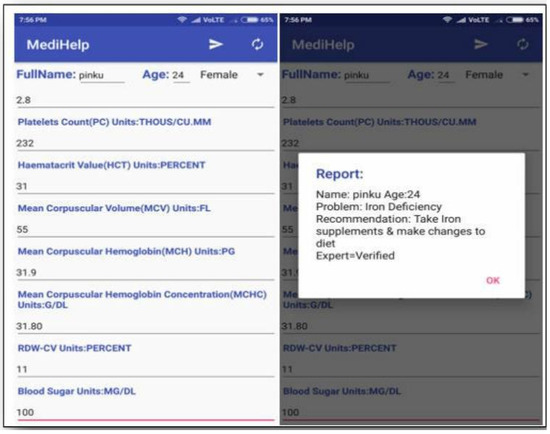
Figure 6.
A user interface to fill in the details of user 1.
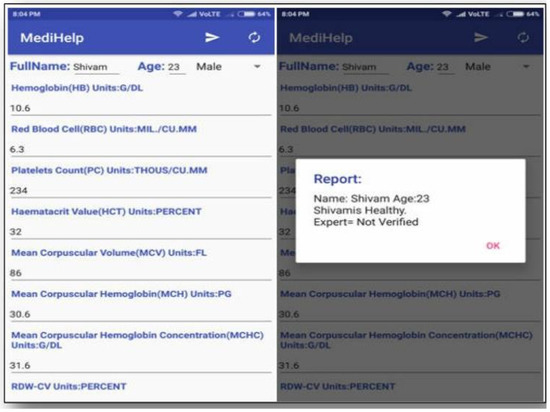
Figure 7.
The user interfaces to fill in the details of user 2.

Figure 8.
User interface with details of the third person.
Figure 6 represents the data input values as sample 1 where the user name is Pinku, whose age is 24 with the mentioned details. Similarly, Figure 7 shows another sample with the name Shivam and age 23.
In Figure 8, the third sample is by a female user named Twinkle aged 30. Based on the input values, the S-ANFIS concluded the Folate Deficiency Anemia and the outcome as a recommendation is to Take Hydroxocobelamin (B12) injection.
This is one way for the users to enter the details. This interface is quite easy to operate and gets the results on the screen. Various backend functions are running to compile and analyze the inputs entered by the user. The results are the proposed model is tested on 500 epochs, 1000 epochs, 1500 epochs, and 2000 epochs with a learning rate of 0.001. The outcome is shown in Figure 9, demonstrated on the 1000 blood samples shown.
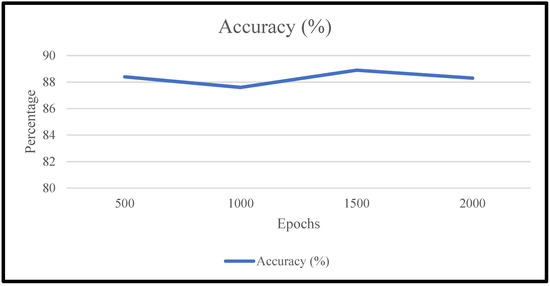
Figure 9.
Comparison of results on various epochs.
The random 1000 samples were taken from the dataset of Rehabilitation acute care hospitals (REHABs) which are defined by the Social Security Administration during the period January through December 2013 available at https://data.world/health/bloodstream-infections-rehab (accessed on 16 March 2022).
If the same results are compared with the three existing models, the result of the proposed model is performing better. In the existing models [16,17,18], the working of models is based on ANN and ANFIS methodology. The results comparison is shown in Figure 10.
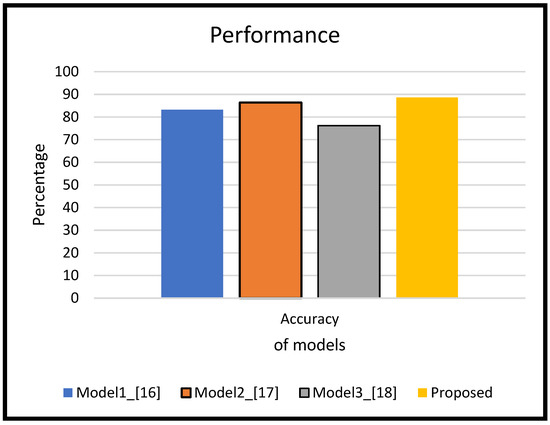
Figure 10.
Comparison of the proposed model with three existing models [16,17,18].
6. Conclusions
The proposed model is designed in such a manner to give automated results to help doctors in identifying the diseases in the blood. Many diseases are not curable in a specific amount of time. In such cases, the proposed system helps a lot in giving descriptions of such cases. The proposed system will be helpful in such circumstances. The suggested concept and algorithm are intended to help end users. Clinicians can accurately detect newly discovered viruses and disorders with the help of the suggested technique. Based on the adaptive neural fuzzy inference system (ANFIS) with content curation and an intelligent analyzer, S-ANFIS is the proposed system. The proposed concept and methodology will make it easy to diagnose blood diseases. The suggested model outperforms with 88.6% accuracy in comparison to the performance of the existing models [16,17,18], which were 83.2%, 86.4%, and 76.2% after testing on the same dataset and on 1000 samples.
Author Contributions
Conceptualization, H.K. and A.K.G.; methodology, H.K.; software, A.K.G.; validation, M.S.; formal analysis, R.R.G.; investigation, A.K.G.; resources, M.S.; data curation, H.K.; writing—R.R.G.; writing—review and editing, H.K.; visualization, H.K.; supervision, A.K.G.; project administration, M.S.; funding acquisition, M.S. All authors have read and agreed to the published version of the manuscript.
Funding
This work was supported by Dongseo University, “Dongseo Cluster Project” Research Fund of 2022 (DSU-20220006).
Data Availability Statement
Dataset from Rehabilitation acute care hospitals (REHABs) is taken for demonstration and simulation purposes. This is defined by the Social Security Administration during the time January through December 2013 available at https://data.world/health/bloodstream-infections-rehab (accessed on 16 March 2022).
Conflicts of Interest
The authors declare no conflict of interest.
References
- Ferraz, A.; Brito, J.H.; Carvalho, V.; Machado, J. Blood type classification using computer vision and machine learning. Neural Comput. Appl. 2017, 28, 2029–2040. [Google Scholar] [CrossRef]
- Vellido, A. The importance of interpretability and visualization in machine learning for applications in medicine and health care. Neural Comput. Appl. 2020, 32, 18069–18083. [Google Scholar] [CrossRef]
- Dong, N.; Zhai, M.; Chang, J.; Wu, C. A self-adaptive approach for white blood cell classification towards point-of-care testing. Appl. Soft Comput. 2021, 111, 107709. [Google Scholar] [CrossRef]
- Atakorah, E.A.; Afranie, B.O.; Addy, K.D.; Sarfo, A.D.; Okyere, B.A. Assessment of intestinal and blood protozoan infections among pregnant women visiting ante-natal care at Tafo Hospital, Ghana. Heliyon 2022, 8, e09968. [Google Scholar] [CrossRef]
- Okaba, K.; Motomura, A.; Horioka, K.; Inokuchi, G.; Chiba, F.; Hoshioka, Y.; Saito, N.; Makino, Y.; Torimitsu, S.; Yamaguchi, R.; et al. Prevalence of blood-borne infections in forensic samples: Epidemiology in areas of Chiba, Japan. J. Forensic Leg. Med. 2022, 90, 102396. [Google Scholar] [CrossRef]
- Toğaçar, M.; Ergen, B.; Cömert, Z. Classification of white blood cells using deep features obtained from Convolutional Neural Network models based on the combination of feature selection methods. Appl. Soft Comput. 2020, 97 Pt B, 106810. [Google Scholar] [CrossRef]
- Lu, Y.; Qin, X.; Fan, H.; Lai, T.; Li, Z. WBC-Net: A white blood cell segmentation network based on UNet++ and ResNet. Appl. Soft Comput. 2021, 101, 107006. [Google Scholar] [CrossRef]
- Shortliffe, E. MYCIN Expert System. Available online: http://www.it.bton.ac.uk/staff/lp22/cs237medicalxSys.html1970s (accessed on 2 March 2022).
- Alshaban, S.; Taher, A.K. Building a Proposed Expert System Used by Blood. Available online: http://www.academicjournal.org/JETR (accessed on 23 December 2021).
- Congiliaro, N.; Disletano, A.; Mirabella, O. An Expert System for Medical Diagnosis. Available online: http://Ieeexplore.ieee.org/document/5450/ (accessed on 11 February 2022).
- Khan, I.V.; Zope, P.; Suralkon, S.R. Importance of ANN in Medical Diagnose Disease Like Acute Nephrities & Heart Disease. Available online: http://www.ijesit.com/vol%202/issue%202/IJESIT201302-33.pdf (accessed on 11 February 2022).
- Mahajan, S.; Shrivastava, G. Effective Diagnosis of Disease through Symptoms Using AI & NN. Int. J. Eng. Res. Appl. (IJERA) 2013, 3, 2229–2231. [Google Scholar]
- Mankad, K.B. Design of Genetic-Fuzzy Based Diagnostic System to identify Chikungunya. Int. Res. J. Eng. Technol. (IRJET) 2015, 2, 153–161. [Google Scholar]
- Yao, C.; Qu, Y.; Jin, B.; Guo, L.; Li, C.; Cui, W.; Feng, L. A Convolutional Neural Network Model for Online Medical Guidance. Volume 4. 2016. Available online: https://www.ieee.org/publications_standards/publications/rights/index.html (accessed on 21 December 2021).
- Singh, A.; Singh, S.; Samson, P. Recommender system for the Detection and the prevention of Dengue. Int. J. Curr. Res. 2010 2017, 9, 1–8. [Google Scholar]
- Tiwari, P.; Qian, J.; Li, Q.; Wang, B.; Gupta, D.; Khanna, A.; Rodrigues, J.J.P.C.; de Albuquerque, V.H.C. Detection of subtype blood cells using deep learning. Cogn. Syst. Res. 2018, 52, 1036–1044. [Google Scholar] [CrossRef]
- Ansari, S.; Shafi, I.; Ansari, A.; Ahmad, J.; Shah, S.I. Diagnosis of Liver Disease Induced by Hepatitis Virus Using Artificial Neural Networks. In Proceedings of the 2011 IEEE 14th International Multitopic Conference, Karachi, Pakistan, 22–24 December 2011. [Google Scholar] [CrossRef]
- Filimon, D.; Albu, A. Skin Disease Diagnosis using Artificial Neural Network. In Proceedings of the 2014 IEEE 9th IEEE International Symposium on Applied Computational Intelligence and Informatics (SACI), Timisoara, Romania, 15–17 May 2014. [Google Scholar] [CrossRef]
- Khodaei-mehr, J.; Tangestanizadeh, S.; Vatankhah, R.; Sharifi, M. ANFIS-Based Optimal Control of Hepatitis C virus epidemic. IFAC-PapersOnLine 2018, 51, 539–544. [Google Scholar] [CrossRef]
- Ayangbekun, O.J.; Bankole, F.O. An Expert System for Diagnoses of Blood Disorder. Int. J. Comput. Appl. 2014, 100, 36–40. [Google Scholar]
- Khurshid, Z.; Warsi, I.; Moin, S.F.; Slowey, P.D.; Latif, M.; Zohaib, S.; Zafar, M.S. Biochemical analysis of oral fluids for disease detection. Adv. Clin. Chem. 2021, 100, 205–253. [Google Scholar] [CrossRef]
- Gour, N.; Khanna, P. Multi-class multi-label ophthalmological disease detection using transfer learning based convolutional neural network. Biomed. Signal Process. Control 2021, 66, 102329. [Google Scholar] [CrossRef]
- Tsai, I.C.; Mayo, L.M.; Jones, B.W.; Stone, A.E.; Janse, S.A.; Bewley, J.M. Precision dairy monitoring technologies use in disease detection: Differences in behavioural and physiological variables measured with precision dairy monitoring technologies between cows with or without metritis, hyperketonemia, and hypocalcemia. Livest. Sci. 2021, 244, 104334. [Google Scholar] [CrossRef]
- Hawley, A. Fuzzy nets: Fuzzy logic and neural networks. In Proceedings of the IJCNN’01. International Joint Conference on Neural Networks. Proceedings (Cat. No.01CH37222), Washington, DC, USA, 15–19 July 2001; Volume 1, pp. 544–546. [Google Scholar] [CrossRef]
- Khatter, H.; Aggarwal, V. Efficient parallel processing by improved CPU-GPU interaction. In Proceedings of the 2014 International Conference on Issues and Challenges in Intelligent Computing Techniques (ICICT), Ghaziabad, India, 7–8 February 2014; pp. 159–161. [Google Scholar] [CrossRef]
- Aggarwal, N.; Kumar, A.; Khatter, H.; Aggarwal, V. Analysis the effect of Data Mining Techniques on Database. Int. J. Adv. Eng. Softw. 2012, 47, 164–169. [Google Scholar] [CrossRef]
- Aggarwal, S.; Aggarwal, J. Neural Network Techniques for Cancer Prediction: A Survey. Procedia Comput. Sci. 2015, 60, 769–774. [Google Scholar] [CrossRef]
- Jangra, A.; Rajput, P.; Dwivedi, D.K.; Lahkar, M. Amelioration of Repeated Restraint Stress-Induced Behavioral Deficits and Hippocampal Anomalies with Taurine Treatment in Mice. Neurochem. Res. 2020, 45, 731–740. [Google Scholar] [CrossRef]
- Gupta, S.P.; Patil, V.M. Recent Studies on Design and Development of Drugs against Alzheimer’s Disease (AD) Based on Inhibition of BACE-1 and Other AD-causative Agents. Curr. Top Med. Chem. 2020, 20, 1195–1213. [Google Scholar] [CrossRef] [PubMed]
- Al-ali, A.; Elharrouss, O.; Qidwai, U.; Al-Maaddeed, S. ANFIS-Net for automatic detection of COVID-19. Sci. Rep. 2021, 11, 17318. [Google Scholar] [CrossRef]
- Islam, M.M.; Karray, F.; Alhajj, R.; Zeng, J. A Review on Deep Learning Techniques for the Diagnosis of Novel Coronavirus (COVID-19). IEEE Access 2021, 9, 30551–30572. [Google Scholar] [CrossRef]
- Nilashi, M.; Ahmadi, H.; Shahmoradi, L.; Ibrahim, O.; Akbari, E. A predictive method for hepatitis disease diagnosis using ensembles of neuro-fuzzy technique. J. Infect. Public Health 2019, 12, 13–20. [Google Scholar] [CrossRef]
- Juneja, A.; Juneja, S.; Kaur, S.; Kumar, V. Predicting Diabetes Mellitus with Machine Learning Techniques Using Multi-Criteria Decision Making. Int. J. Inf. Retr. Res. 2021, 11, 38–52. [Google Scholar] [CrossRef]
- Rashid, J.; Batool, S.; Kim, J.; Wasif Nisar, M.; Hussain, A.; Juneja, S.; Kushwaha, R. An Augmented Artificial Intelligence Approach for Chronic Diseases Prediction. Front. Public Health 2022, 10, 860396. [Google Scholar] [CrossRef]
- Padmavathy, T.V.; Vimalkumar, M.N.; Bhargava, D.S. Adaptive clustering based breast cancer detection with ANFIS classifier using mammographic images. Clust. Comput. 2019, 22, 13975–13984. [Google Scholar] [CrossRef]
- Tokachichu, J.; Gaddam, T.R.D. Performance analysis of a transmission line connected with UPFC designed with three level cascaded H bridge inverter with generalized SVM technique using PI, FUZZY LOGIC, ANN and ANFIS controllers. Mater. Today Proc. 2022, 51 Pt 1, 1243–1251. [Google Scholar] [CrossRef]
- Zhang, Z.; Peng, B.; Luo, C.; Tai, C. ANFIS-GA system for three-dimensional pulse image of normal and string-like pulse in Chinese medicine using an improved contour analysis method. Eur. J. Integr. Med. 2021, 42, 101301. [Google Scholar] [CrossRef]
- Behnood, A.; Golafshani, E.M.; Hosseini, S.M. Determinants of the infection rate of the COVID-19 in the U.S. using ANFIS and virus optimization algorithm (VOA). Chaos Solitons Fractals 2020, 139, 110051. [Google Scholar] [CrossRef]
- Zardkoohi, M.; Molaeezadeh, S.F. Long-term prediction of blood pressure time series using ANFIS system based on DKFCM clustering. Biomed. Signal Process. Control. 2022, 74, 103480. [Google Scholar] [CrossRef]
- Seifallahi, M.; Mehraban, A.H.; Khamseh, F.; Salehi, M.; Hajati, G.; Khansari, M.; Ahmadzadeh, M.; Babaie, M. Detection of mild cognitive Impairment from gait using Adaptive Neuro-Fuzzy Inference system. Biomed. Signal Process. Control. 2022, 71 Pt B, 103195. [Google Scholar] [CrossRef]
- Raghav, G.; Khatter, H. Intelligent Curation Fuzzy Inference System for Blood Infections in Android. In Proceedings of the IEEE 4th International Conference on Computational Intelligence & Communication Technology (CICT), Ghaziabad, India, 9–10 February 2018. [Google Scholar]
- Raghav, G.; Khatter, H. Blood Diagnostic Disease Using the Fuzzy Inference System and Neural Network. International Journal of Scientific Research in Computer Science. Eng. Inf. Technol. 2017, 2, 1–6. [Google Scholar]
Publisher’s Note: MDPI stays neutral with regard to jurisdictional claims in published maps and institutional affiliations. |
© 2022 by the authors. Licensee MDPI, Basel, Switzerland. This article is an open access article distributed under the terms and conditions of the Creative Commons Attribution (CC BY) license (https://creativecommons.org/licenses/by/4.0/).